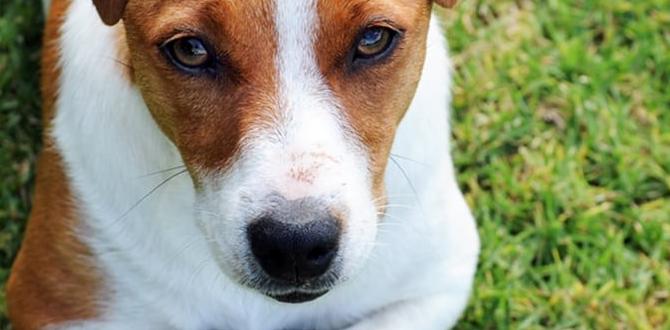Have you ever wondered why some dogs bite? It’s a common concern for many people. Dogs can bite for many reasons. Sometimes they are scared or feeling threatened. But don’t worry! We can learn ways to prevent dog bites. In this article, we will explore dog biting prevention step by step. Let’s make sure our furry friends and everyone around them stay safe.
Key Takeaways
- Understand your dog’s feelings to prevent bites.
- Be calm and gentle when around dogs.
- Learn dog biting prevention step by step for safety.
- Never disturb a dog while it’s eating or sleeping.
- Teach kids how to interact with dogs safely.
Recognizing Dog Emotions to Prevent Biting
Understanding dog emotions is the first step in preventing bites. Dogs express their feelings through body language. A dog may wag its tail when happy or growl when scared. Observing these signs helps us know when a dog feels uncomfortable. Speaking softly and moving slowly can help reduce a dog’s stress. Always give a dog space if it seems anxious. Never force interaction. Let the dog approach you first if it wants to.
- Watch a dog’s tail and ears.
- Listen for growling or barking.
- Observe a dog’s posture and movements.
- Notice if the dog avoids eye contact.
- Be aware of lip licking or yawning.
By recognizing dog emotions, we can change how we interact with them. This leads to safer encounters and happy dogs. Remember, each dog is unique. What works for one might not work for another. Pay attention and adapt your approach to suit the dog you are with. Dogs trust those who respect their boundaries.
Fun Fact or Stats : Dogs can sense human emotions, like happiness and sadness.
Understanding Dog Body Language
Have you ever seen a dog wag its tail happily? That’s one way they communicate. Dogs use body language to express how they feel. A stiff tail might mean tension, while a relaxed tail shows comfort. Observing a dog’s ears can also give clues. Are the ears perked up or laid back? Knowing these signs helps us interact better. It’s like learning a new language. Do you think you can become a dog language expert?
The Importance of Giving Dogs Space
Imagine if someone always hugged you without asking. You might feel uncomfortable, right? Dogs feel the same way. They need space and time to get comfortable around new people. Always let them approach you first. If they walk away, don’t chase them. It’s important to respect their boundaries. Have you ever seen a dog hiding under a table? That’s a sign it needs some alone time. Give it space and it will come back when ready.
When to Avoid Dog Interaction
Do you know when not to approach a dog? If a dog is eating or sleeping, it’s best to leave it alone. Dogs are protective of their food. They might snap if disturbed while eating. Similarly, a sleeping dog can be startled when woken suddenly. This can lead to a bite. Always ask the dog’s owner if it’s okay to pet their dog. This shows respect and ensures safety for both you and the dog. Have you ever been interrupted while eating? It can be annoying, right?
Teaching Kids Safe Dog Interactions
Children love dogs! But they need to learn how to interact safely. Teach kids to approach dogs slowly and quietly. Encourage them to hold out a hand for the dog to sniff. If a dog shows interest, gently pet the dog on the back, not the head. Explain that pulling ears or tails is not allowed. This can hurt the dog and cause it to bite. Kids should learn to read dog body language, too. This helps them understand when a dog wants to play or be left alone.
- Approach dogs slowly and quietly.
- Let the dog sniff your hand first.
- Pet gently on the back, not the head.
- Avoid pulling ears or tails.
- Read the dog’s body language.
By teaching kids these simple rules, we keep them and dogs safe. Encourage children to respect dogs as living beings with feelings. This helps build trust and friendship between them. Have you ever seen a child and dog become best friends? It often starts with understanding and kindness.
Fun Fact or Stats : Dogs have been companions to humans for over 14,000 years!
Why Dogs and Kids Make Great Friends
Isn’t it amazing how kids and dogs become friends so easily? Dogs are loyal and playful, making them great companions for children. Kids learn responsibility and empathy by caring for a pet. They also gain a friend who offers unconditional love. It’s important to guide this friendship with safety in mind. Have you ever had a pet as a best friend? They can bring so much joy!
Simple Rules for Kids Around Dogs
Rules help keep everyone safe. Remind kids to ask before petting a dog. Teach them to avoid hugging dogs tightly, as this can make them nervous. Encourage them to listen to the dog’s body language. If a dog moves away, it’s time to give it space. These simple rules make playtime enjoyable for both kids and dogs. Do you have any rules you follow with your pet?
Explaining Dog Safety to Kids
How do you explain dog safety to kids? Use simple stories and examples. Tell them why giving a dog space is important. Explain that dogs have feelings and can get scared or angry. Use fun activities to teach about dog behavior. Do you know any games that teach about dog safety? Making learning fun helps kids remember the rules. It builds a foundation for safe interactions.
Step-by-Step Guide to Approaching Dogs
Approaching a dog for the first time can be exciting or scary. Here’s a step-by-step guide. First, ask the owner if it’s okay to approach the dog. Next, extend your hand for the dog to sniff. This allows the dog to know your scent. If the dog seems calm, gently pet its back. Avoid sudden movements. Don’t stare directly at the dog’s eyes, as this can be intimidating. Always let the dog make the first move towards you.
- Ask the owner for permission.
- Let the dog sniff your hand.
- Pet gently on the back.
- Avoid sudden movements.
- Avoid direct eye contact.
Following these steps helps build trust between you and the dog. Remember, each dog is different. Some may warm up quickly, while others take time. Be patient and respectful. This step-by-step approach reduces the risk of bites and creates positive experiences with dogs. Have you ever felt nervous around a new animal? This guide can help ease those fears.
Fun Fact or Stats : Dogs have an incredible sense of smell, much stronger than humans.
Why Permission Matters Before Approaching
Why is it important to ask before approaching a dog? Imagine if a stranger ran up to you and patted your head. You might feel surprised or scared. Dogs feel the same way. Asking the owner for permission shows respect for the dog’s space. It also ensures the dog is friendly and safe to approach. Have you ever had to ask permission for something important? It’s always better to be safe than sorry.
Building Trust with New Dogs
How do you build trust with a new dog? Start slow. Let the dog come to you. Avoid making loud noises or sudden movements. Offer a treat if the owner allows it. Speak softly and move gently. Trust takes time but is worth the effort. Have you ever gained a pet’s trust? It’s a rewarding experience that leads to a wonderful friendship.
Understanding Dog Reactions
Have you ever seen a dog back away from someone? This is a reaction that can mean the dog is unsure or scared. Understanding these reactions can prevent bites. If a dog backs away, give it space. It might take time to feel comfortable. Never push a dog to interact. Respect its feelings and approach it later when it seems ready. Dogs appreciate patience and understanding.
How to Handle Dog Encounters in Public
Meeting dogs in public is common. You might see them at parks or on walks. Here are tips for handling these encounters. Always keep a safe distance until the owner gives permission. Observe the dog’s behavior. Is it calm or agitated? Speak softly to the dog to show you mean no harm. Never run towards a dog. This can startle them. If a dog seems aggressive, stay calm and slowly walk away.
- Keep a safe distance initially.
- Observe the dog’s behavior.
- Speak softly to the dog.
- Never run towards a dog.
- Walk away if the dog seems aggressive.
Public spaces are great for socializing, but safety comes first. Respecting a dog’s space ensures positive experiences. If unsure, ask the owner for guidance. Most dog owners are happy to help and share information about their pet’s personality. Have you ever met a new dog in a park? It can be an exciting experience if done safely.
Fun Fact or Stats : There are over 340 different dog breeds worldwide!
Understanding Park Etiquette with Dogs
Have you ever wondered how to behave around dogs in a park? Parks are fun for dogs, but they need their space. Always ask the owner before petting a dog. Be aware of where you are walking, so you don’t startle a dog by accident. If you have your own dog, keep it on a leash unless in a designated area. Respect other dogs’ spaces and follow park rules. This makes the park enjoyable for everyone.
Interacting with Dogs on Walks
Do you know what to do when you see a dog on a walk? First, smile at the owner to show you’re friendly. Ask if you can say hello to their dog. If they agree, let the dog sniff your hand. Speak softly and move slowly. This shows the dog you mean no harm. Always remember to thank the owner afterward. Have you ever made a new dog friend on a walk?
What to Do If a Dog Seems Scared
If a dog seems scared, what should you do? Stay calm and avoid eye contact. Dogs can sense fear and tension. Speak softly to reassure the dog. Back away slowly to give it space. Let the owner handle the situation. This keeps both you and the dog safe. Have you ever seen a dog that seemed frightened? Knowing what to do helps prevent bites and builds trust.
Understanding Why Dogs Bite
Why do dogs bite? Several reasons can lead to biting. A dog might bite if it feels scared or threatened. It might also bite if it’s protecting its territory or owner. Sometimes, a dog might bite because it’s hurt or in pain. Understanding these reasons helps us prevent bites. By knowing what triggers a dog, we can avoid those situations. Educating ourselves and others about dog behavior helps keep everyone safe.
- Fear can cause a dog to bite.
- Protecting territory might lead to biting.
- Pain or injury can make a dog bite.
- Stress can cause aggressive behavior.
- Improper training might lead to biting.
Understanding why dogs bite is crucial for prevention. Most dogs don’t want to bite. They do it as a last resort. By recognizing the signs and avoiding triggers, we can keep bites to a minimum. Have you ever met a dog that seemed nervous? Knowing what to look for helps us react appropriately.
Fun Fact or Stats : Dogs can recognize up to 165 words!
Recognizing a Scared Dog
Can you tell when a dog is scared? Look for signs like shaking, hiding, or tucking its tail. A scared dog might also show its teeth or growl. These signs mean the dog needs space and time to calm down. Never approach a scared dog. Give it some distance and let it come to you when it’s ready. Have you ever seen a dog behaving this way? Knowing the signs helps in preventing bites.
Common Triggers for Dog Bites
What makes a dog bite? Common triggers include loud noises, sudden movements, or unfamiliar people approaching too quickly. Dogs may also bite if they feel cornered. Always be aware of your surroundings when near dogs. Understanding triggers helps us prevent accidents. Have you ever been startled by a loud noise? Dogs feel the same way and might react by biting.
The Role of Training in Biting Prevention
Can training help prevent dog bites? Yes! Training teaches dogs to behave well and react calmly. A well-trained dog is less likely to bite. Training also helps owners understand their dog’s needs. Using positive reinforcement, like treats and praise, encourages good behavior. Have you ever trained a pet? It takes patience, but the results are worth it. A trained dog is a happier, safer pet.
Conclusion
Preventing dog bites is important for everyone’s safety. By following dog biting prevention step by step, we can avoid accidents. Recognize dog emotions and give them space. Teach kids how to interact safely. Always ask before approaching a dog. With these steps, we can enjoy happy moments with our furry friends. Let’s all work together for a safer, friendlier world for dogs and humans.
FAQs
Question: Why do dogs sometimes bite people?
Answer: Dogs might bite due to fear, pain, or feeling threatened. Recognizing these emotions helps in prevention. By understanding triggers like loud noises or unfamiliar people, we can reduce the risk of bites. Learning dog biting prevention step by step is key to safety.
Question: How can I teach kids to interact safely with dogs?
Answer: Teach kids to approach dogs slowly and gently. Let them offer a hand for the dog to sniff. Explain that they should pet dogs on the back, not the head. Encourage them to learn dog body language. This step-by-step guide ensures safe and happy interactions.
Question: What should I do if a dog seems aggressive?
Answer: Stay calm and avoid sudden movements. Slowly back away and give the dog space. Avoid eye contact, as this can be seen as a challenge. Tell an adult if you feel unsafe. Knowing how to react is part of dog biting prevention step by step.
Question: Why is it important to ask permission before petting a dog?
Answer: Asking permission shows respect for the dog and its owner. It ensures the dog feels comfortable and safe. This reduces the risk of bites and helps create positive experiences with dogs. Always ask before approaching a new dog.
Question: How can training prevent a dog from biting?
Answer: Training teaches dogs good behavior and helps them react calmly to situations. It reduces fear and stress, which are common reasons for biting. Using positive reinforcement, like praises and treats, encourages dogs to behave well.
Question: What are some signs that a dog is scared?
Answer: A scared dog may shake, hide, or tuck its tail. It might also growl or show its teeth. Recognizing these signs means giving the dog space. Never approach a scared dog, as this can lead to a bite. Understanding these emotions is key to preventing bites.
Meet Elyse Colburn, the devoted canine companion and storyteller behind the enchanting world of “Tales, Tails, and Adventures Unleashed.” A passionate dog enthusiast with a heart full of paw prints, Elyse Colburn shares heartwarming tales and insightful adventures, celebrating the joy, loyalty, and endless antics that make every dog a true hero. Join Elyse Colburn on this tail-wagging journey, where every post is a love letter to our four-legged friends.








